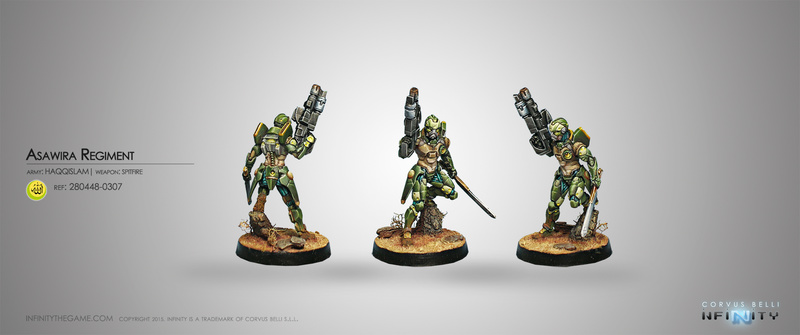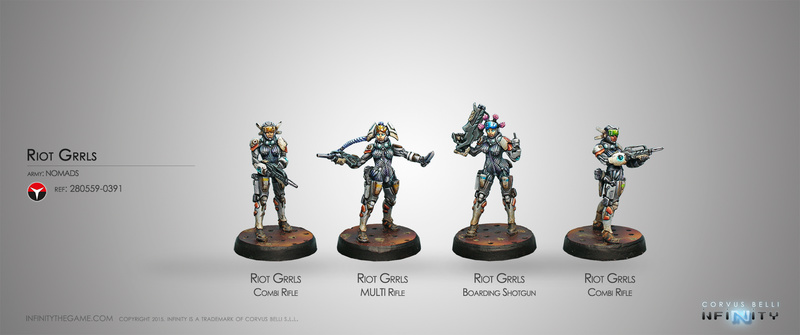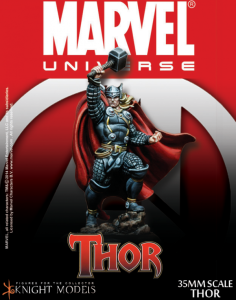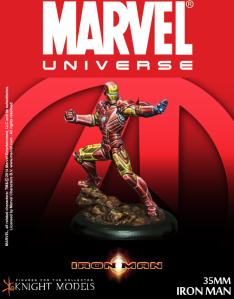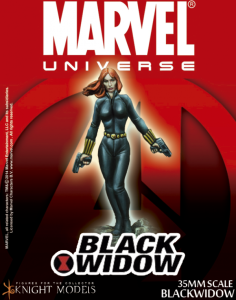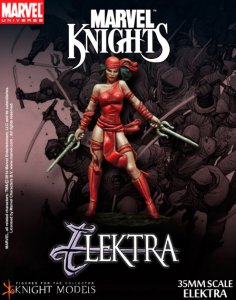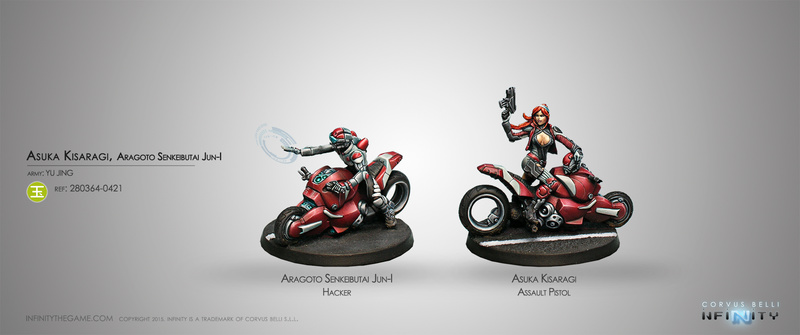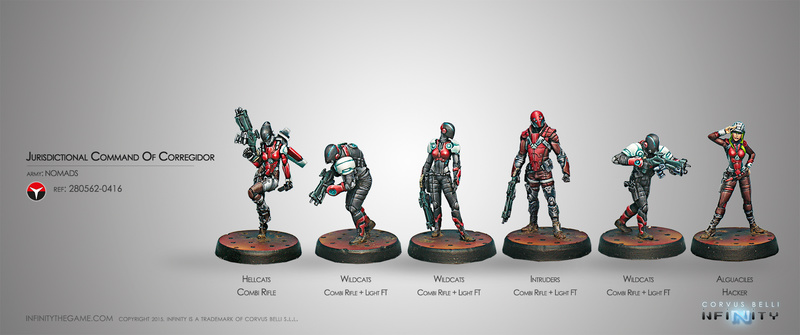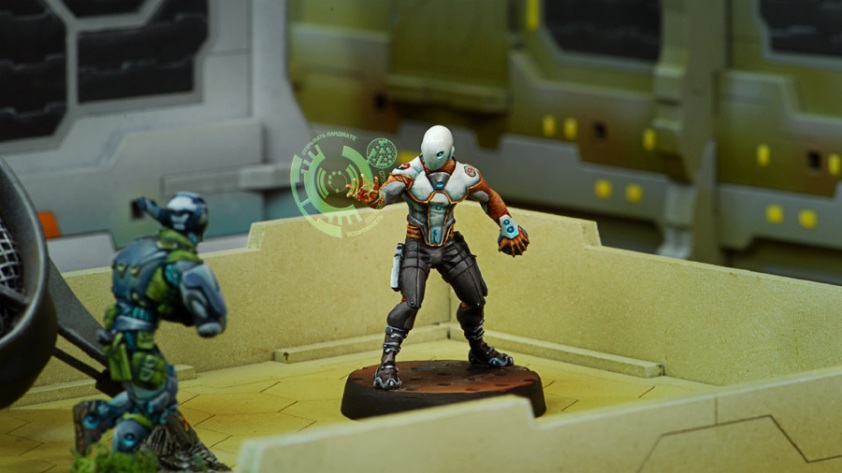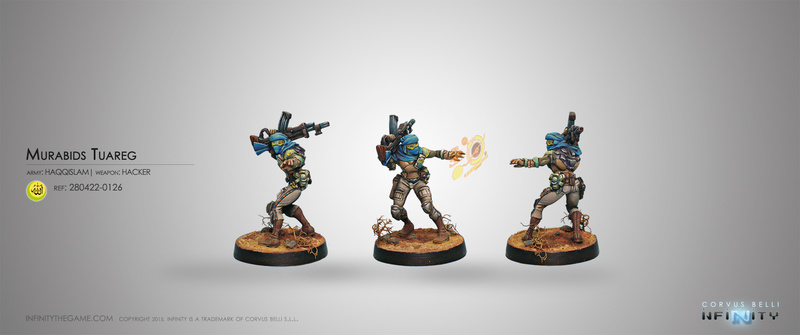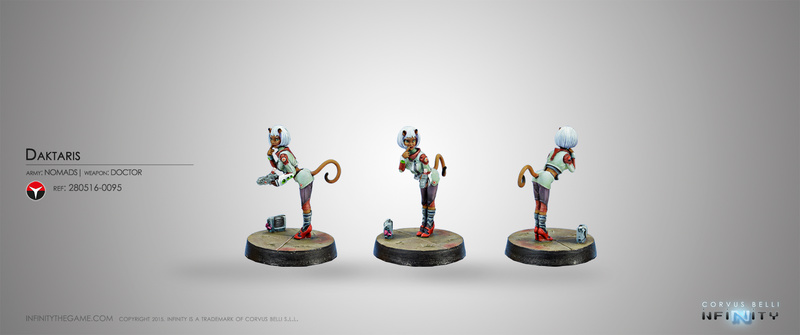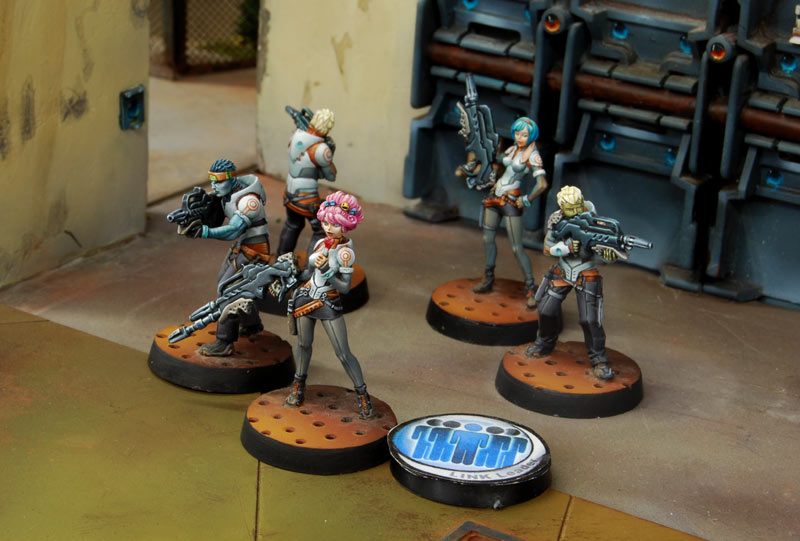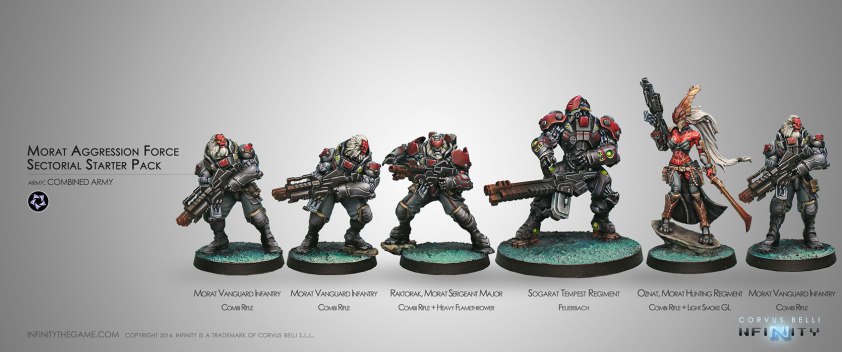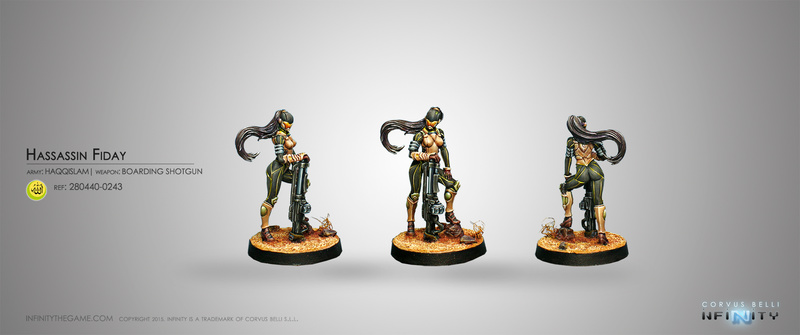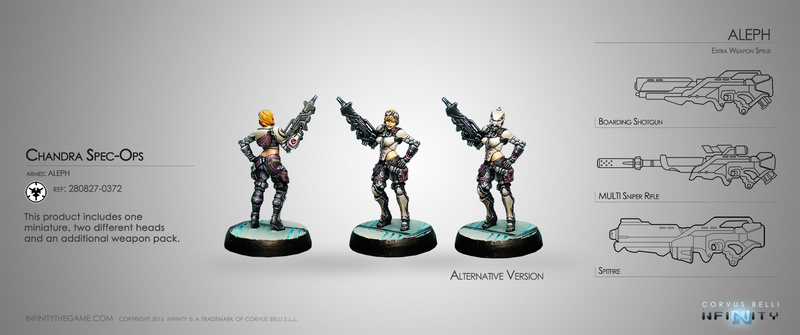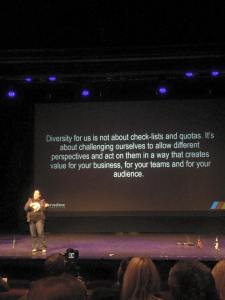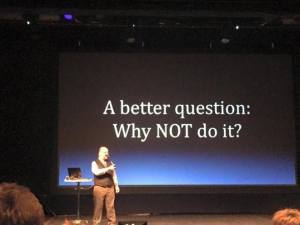I’ve moved out here, so change your RSS 😉
Discussion #1
After the last post, I had quite many interesting discussions about miniatures. Some of you pointed out problems with my analysis of Knight Models. One of my friends told that poses are actually “majestic” in both cases and another friend one mentioned that minis depict stances from comics, so as you can see, problem lies in comics, not in the minis. Moreover, “majestic pose” is something different than active or passive one and I’m not sure how to approach that (but I will think about it for sure). Regardless of that, when I take Knight Models under scrutiny one more time, I will keep in mind your discussions and comments. Also, I’m grateful for pointing out other mistakes. You’re awesome, thanks!
I had a long discussion about how I’m evaluating Infinity minis. I shortly described this process, but it’s a little bit more complicated, so I will try to explain it here. My friend sent me this photo (each photo was taken from Corvus Belli store):
He asked if I evaluated this minis as a woman or man, since armor doesn’t exactly indicate any secondary gender characteristics and what is more is that the armor actually shows a bit breast shape (there’s even a discussion about that on Infinity forum).
I’ve been interested in Infinity for a couple of years. I’ve seen changes in design and sculpting and what I can say is that: no breast = it’s a man, even if she wears a heavy armor. Let’s take a look at some examples:
Riot Grrls wear heavy armors and we’re still able to tell that they’re women (by the way, the’re all rather passive, aren’t they? Even the last mini doesn’t really look like she wants to shoot something).
They’re wearing rather medium armors, but breast is clearly visible. Of course armors for women must have a different shape, but I wouldn’t call it a “boob shape” – it’s all about leaving enough empty space. Here you have nice tumblr showing reasonable armors. Let’s have more cool links about medieval armors and why boob armor might kill you.
However, there’s one mini without that visible breast:
But she’s very small, smaller than Tohaa diplomat (I think photo doesn’t show that, you need to have minis in your hands) and delicate. That indicates that she’s a woman and of course it’s nothing wrong, but it shows that designers do not want to make indistinguishable minis. The questions is why? We do not have any data on which minis are being sold in larger amounts and any research describing how people perceive gender in minis. It would be nice to have, because I think that if company like Corvus Belli started doing not-so-obviously-gendered minis, it might have an impact on their revenue. Do you know any similar research connected to how people perceive gender? Coming back to the topic – design analysis allows me to “learn” how minis are created and it helps me what a mini really depicts. Also, taking into consideration general trends in designing minis, I would be surprised if such company as Corvus Belli would have not-so-obviously-gendered minis.
Some of you sent me links to nice female minis, here they’re:
Thank you for all your discussions and contributions – you really make me a better writer and researcher.
What’s (sometimes) wrong with you, miniatures? #1
I’m a miniature painter and sometimes I play historical and non-historical wargames but I’m rather more into painting. I don’t limit myself to scale or company. By scale I mean the size of miniatures which may vary from 2mm to even 60mm or bigger. Quite often I buy and then paint minis for my friends – it’s my way of giving birthday gifts.
I’m also a feminist and I like diversity. Whenever I’m trying to find a nice mini depicting women in full armor, nice dress and similar, I usually fail or choose lesser evil if I can correct the mini with green stuff (covering strange holes in the armors like naked stomachs, getting rid of high heels and so on).
I fail because it’s hard to find a mini without cleavage, ridiculous armors which rather show body than protect it. Women miniatures are sexualized in many ways. Moreover, their pose might be boring and by boring or rather passive I mean posing like a model or looking like waiting for a bus. In other words – female miniatures might look like pin-up girls or fetish models (but keep in mind that there’s a place for such minis also).
Don’t get me wrong – it’s nice to have choice and this choice includes naked barbarians and Amazons. Everything depends on the context. Conan and Red Sonja don’t really bother about proper clothing (at least sometimes, Conan was actually wearing full armor when needed). But when it comes to boob armor on the battlefield where guys are wearing full body armors, there’s something wrong. Of course naked or barely clothed minis are good painting challenges and they just look good (when sculpted properly, of course). The problem is that when it comes to women, the choice might be limited in some cases.
Basing on the miniatures from two quite popular companies, I will show you how female miniatures just look wrong, because being sexy is more important than anything else.
I will do two things – count the number of women minis in a given line/game and analyze their look. At the moment, I take into account only non-historical games, so no companies providing only minis without a game, not historical systems. They require different approach (and I still haven’t figured out how I should analyze them).
Unfortunately, there’s not much research into wargames in general and we’re not going to find anything for miniature wargames. However, Hatton and Trautner wrote a good paper about Rolling Stone’s covers where they’re analyzing women depiction on them, so what I want to do. I will use the same categories to analyze minis (clothing/nudity; touch; pose; mouth; breasts/chest and genitals, buttocks; text; head vs body shot; sex act; sexual role-play). Since analyzing images is different than miniatures, applying all these categories might be a little bit tricky, but I will try to be clear and comprehensive as possible.
This company mostly provides Marvel and DC superheroes miniatures. The presence and image of women is limited by comics themselves, but there are still some things which I can argue about. I’m going to scrutinize Marvel line of minis. It’s not a big company, but I decided to write about since it shows that some disproportions and sexism might be present regardless of the universe which miniatures are based on.
Firstly some numbers. There are 47 miniatures in two different scales and 5 women (or 4 if we don’t count doubled Elektra in two scales) among both superheroes and supervillains. Comics universe is huge, I bet one can find more superheroines and supervillains than these four. If not stated otherwise, each image has been taken from Knight Models website.
Let’s take a look at some male superheroes, for example Thor:
And here’s Iron Man:
Cool mighty guys. The only women available in Marvel line are Elektra, Black Widow, Black Cat and Miss Marvel.
I can’t say anything about Elektra’s outfit – it’s just like in comics. Nothing wrong to say about Black Widow’s clothes either – no cleavages and other things. But there’s problem with a pose. When it comes to category pose, Hatton and Trautner described and scored it like that:
Images in which the cover model was not posed in any way related to sexual activity — standing upright, for example — scored ‘‘0’’ in this category. Images scored ‘‘1’’ for a variety of poses that were suggestive or inviting of sexual activity, including lifting one’s arms overhead and any kind of leaning or sitting. Images that scored a ‘‘2’’ on this measure were overtly posed for sexual activity; this included lying down or, for women, sitting with their legs spread wide open.
So in authors’ classification, Elektra and Black Widow would probably get zero. That’s good, isn’t it? Well, yes, they’re not sexualized, but as I said, some poses might be boring and this is the cases here. Look at Thor or Iron Man – they’re in action, doing something (fighting with evil!). Elektra and Black Widow are just standing and staring at you. Of course we need such figures, but when it comes to Marvel line from Knight Models, the two most boring minis are the only women – rest of the figures are more dynamic and thus interesting. In comics we can see passive Thor and active Black Widow and other way around, but for some reason in case Marvel line, men are the only active ones. The issue of boredom is present in many other cases.
Maybe something bigger this time? Like Spanish Corvus Belli and its game called Infinity
Infinity is a skirmish game meaning that armies are small (usually from 10 to 15 miniatures). This game is set somewhere in the future.
Here we’re going to have more statistics. General number is a number of all the miniatures. Number of non-characters miniatures indicate the number of robots, vehicles and monsters without clear gender characteristics. In brackets you have a number of characters. I took into account monster-like characters (such as werewolves in Ariadna) since I can clearly point out secondary gender characteristics in them.
Mercenaries is not a playable army in Infinity, but bunch of miniatures which you can use in other armies, so that’s why I decided to include them. There are other miniatures such us bootlegs or limited editions, but since they’re main purpose isn’t playing, I didn’t include them.
| Army | General number | Number of non-characters | Women | % |
| Ariadna | 99 | 2 (97) | 14 | 14.43 |
| PanOcenia | 94 | 16 (78) | 19 | 24.36 |
| YuJing | 84 | 16 (68) | 16 | 23.53 |
| Haqqislam | 95 | 8 (87) | 23 | 26.44 |
| Nomads | 106 | 24 (82) | 33 | 40.24 |
| Combined Armies | 82 | 12 (70) | 8 | 11.43 |
| Mercenaries | 28 | 3 (25) | 7 | 28 |
| Tohaa | 47 | 5 (42) | 9 | 21.43 |
| Aleph | 76 | 17 (59) | 21 | 35.59 |
Isn’t it a little bit sad? Popular argument for this kind of proportions is that in real world there is always less women in army. Well, Israeli Defense Forces consist of over 30% of women and Norway has just started including women into army duty. But what is more important is that Infinity is set in faraway future, so being weaker than a man is not a problem and you know, among aliens gender might not be the case at all in going on war. In any fraction description there’s nothing about prevalence of men in the army. Haqqislam’s description emphasizes how this nation is progressive (and thus aiming into equality).
But why we need to include more women? David Gaider would answer (or rather answered during Nordic Game) “Why not?” Let’s be more elaborate, however. David Gaider during his keynote told us that it’s simply more interesting to have diverse characters in the game. Diversity opens for you new routes of creating the history. Gaider told one more interesting thing – he said that many handicapped and other people write to him because they want to feel included, represented in the games. I bet you all would love to see yourselves in games.
People from gaming industry and researchers have also something to say about diversity and why it is nice to have it:
Social diversity promotes the emergence of cooperation in public goods games
Peter Moore about diversity in games
Head of Xbox, Phil Spencer talks about diversity also
Andy Payne at European Women In Games Conference
Now is time for photos and overall image of female miniatures in Infinity. If not stated otherwise, each photo was taken from Corvus Belli store.
I think this is my favorite example clearly showing what is sometimes wrong with miniatures. Men – full body armor and pose saying “ready to rock!”. Women – boob window (hey, look at this, even DC tries to get rid of boob window!) and, I think, broken spine? I mean it’s pretty impossible or very difficult to sit like that. If we forget about it for a while, we say that she is posing like a model during photo session. And she must be freezing when driving. Her suite (comparing to her partner’s) doesn’t look as it can protect from the cold wind.
Actually, YuJing army doesn’t contain very bad examples of sexualized/passive women, but still it doesn’t have many women in general (I bet at some point there will be more vehicles and robots in this army than women).
3 women, 3 guys, nice! But why this blond girl looks like she’s doing something with her hair? And in general being very passive? Description below says that she’s a hacker. It’s rather self-explanatory. But we barely see her weapon and, in general, any hacking-like activities which are nicely showed on these minis:
Fortunately other women look good and there’s even a passive guy which I like since they’re rarely passive. [Alert, personal opinion]: but I think I’d prefer all minis to be active – after all they’re fighting all the time?
Time for something which I really don’t understand
Why. Just why. You’re on the battlefield, but you look like from the cover of some fashion magazine. Or soft porn one. Just to be clear – there are no men like that in Infinity. If we applied Hatton and Trautner framework for analyzing her, she would probably get 1 point for pose, 2 points for mouth and 1 point for sexual role play.
I promise, this is the last example from this army:
Seriously, lollipop? Fortunately her partners are ready to shoot something, because she is focused on eating lollipop. If she were a guy, I would be pissed off as well. Maybe that’s just me, but lollipops do not belong to the battlefield. Also, look at the whole scene – men are fighting, women are looking.
As I promised, something else:
I really like this starter and design of armors. Except one. Boob armor isn’t an armor. And there’s one more interesting thing – 3 guys out of 4 are active, 1 woman out of 1 woman is passive. I can’t find any explanation why she isn’t wearing armor for battle (and I hope it isn’t anything like that).
“Please let me be on Cosmopolitan cover”? Look at her pose, her hips. I strongly recommend googling “Cosmopolitan” covers and see a big resemblance.
This is not how are you holding a gun when you’re not using it, I guarantee that. It might be actually pretty dangerous. Have I mentioned that her pose looks like a pose of pin-up girl? She wouldn’t probably get much points from Hatton and Trautner, but keep in mind we’re talking about warriors who are constantly fighting with each other. I wouldn’t mind if she sits or just stands (like for example this guy), but she basically shows us her butt.
There are plenty of minis with strange armors uncovering vital points of their bodies like this one:
I just showed you a sample (you can find more on your own, take a look for example on her), but as I mentioned at the beginning, this sample is usually half of the women in the army. There are active women in nice armors (in YuJing army), but they’re exceptions. When I point out problems with women in Infinity, many people say that “it’s mangaaaa style!”. Apart from that in many mangas women aren’t partially naked all the time, haven’t you ever been concerned why in some women are (over)sexualized all the time?
Another argument is that “but it seeeeells!”. Unfortunately, there’s no hard data who buys Infinity minis, but I wouldn’t be surprised if most of the customers were white heterosexual male. In fact, this conclusion has some support in research. Gary Alan Fine, American sociologist, conducted research into role players’ culture at the beginning of hobby development. Long story short, many people, mostly men (according to Fine, only 10% of players were women) were sexist and were discriminating women. As you may know, RPGs come from wargames, so I think it’s safe to say that wargaming society was masculinized and probably sexist as well in 60s and 70s. But this only a suggestion, I don’t have really anything to support this idea. Only some anecdotal data based on participation in the wargaming societies. But as we can see in the linked interviews and pieces about diversification in video games, diversity helps to get more players into games, especially women. But again, we don’t know much about how wargaming society looks like now, so in order to say anything about that, we should probably conduct similar research as Fine’s one.
Let’s talk about men for a while. We already now there’s way more of them than women. I can guarantee that you’re not going to find men posed like Hassassin Fiday or Bakunin Moderator. If some body parts are not covered, they’re usually muscular arms. However, there’s Saladin who isn’t overmuscled man and wears nice armor. I bet you wouldn’t buy army consisting mostly of barely clothed muscled men posing like models during photo session to new fashion catalogue. Maybe that’s the reason why women are not interested in miniatures, because they’re basically boring and sometimes sexist comparing to the male counterparts?
Next stop: Warhammer.
Books, books and books #1
My Bachelor’s Degree isn’t connected anyhow to Game Studies, so in order to teach myself something about them. I talked to people who know something about that and started picking up books which sounded like a good start. At least for me this is the best way to start getting familiar with some topic. Of course you might not understand some concepts at the beginning, but the more you read, the more knowledge you gain and everything becomes clearer and clearer. It might sound very “chaotic”, but reading books which just sound interesting is the best way for me to get familiar with a give topic. I also like checking university curricula (like this one from Ashley ML Brown) for inspiration. They’re usually pretty good.
I prepared for you a short list of books about role-playing games which I really recommend to read (rather sooner than later):
Appelcline, S. (2015). Designers & Dragons. Evil Hat Productions. – it’s a second edition of elaborate history of RPG industry. It consists of four volumes and each of them describes thoroughly a given episode in the industry. You can find there a lot of information about your favourite games and their history. Moreover, the style of writing is approachable, so if you were scared of academic tone then you’re not going to find it there
Fine, G. A. (2002). Shared Fantasy: Role Playing Games as Social World. Chicago: University of Chicago Press. – the only such big sociological research into RPG culture. For one year, Fine was playing with different people in order to describe American role players’ culture. Many issues raised by Fine are still valid today (like sexism), so if you want to write about RPGs then this book is a “must-read”
Peterson, J. (2012). Playing at the World. San Diego: Unreason Press. – Jon Peterson isn’t an academic, but it didn’t stop him to write a book about the first role-playing game – “Dungeons and Dragons (and general development of the hobby).
Apart from these nice books, you can take a look at International Journal of Role-Playing – it’s free (and you can submit a paper there if you want).
Some kind of sum up
My first academic year in Finland just passed and I’m sitting now in Poland writing abstracts and reading science-fiction books. Finns are constantly asking me why I have moved to Finland – to this dark country full of depressed people and harsh long winter. Well, usually my answer is “because I wanted to”, but there are several reasons connected with studying in Finland which appeal to me. Most of them is connected with studying. I will try to present major differences between the University of Tampere (UTA) and Warsaw University (UW) and some general characteristic features of academic culture.
Numbers
Obviously Poland is a way bigger than Finland and thus the number of students is higher. 45k people are currently studying at UW doing their Bachelor’s or Master’s degrees. 3k PhD candidates. UW at its disposal has 124 buildings. At UTA there is only 15,5k of students and 1,613 PhD candidates. The difference is huge. In Poland one university might accept 70 people for PhD program, whereas at UTA maybe 8, but as you can see, the difference between UW and UTA isn’t that big. UW has three campuses and UTA one.
I’m aware of that that Warsaw is a capitol city and Tampere not, but Aalto University in Helsinki consists only of around 18k students right now.
Students
I don’t have any data and I’m not sure if exists, but average age of Finnish students is higher than Polish ones meaning that on Master’s Degree you might study with someone in his or her 30s and this is perfectly normal. In Poland such old people aren’t warmly welcomed by other, younger students (of course it really depends, but I have an impression that general approach towards them is rather hostile). I talked to some Finns about how they are studying and they explained to me that they are not usually going straight after high or vocational school studying (especially after vocational school). Sometimes they want to do only Bachelor’s Degree and then go to work. In Poland almost everyone heads to the university after finishing high school. Reasons for that might be several – current condition of employment and social welfare forces people to do a degree as soon as possible (and probably work during that) because without a diploma it is extremely difficult to find a job (well, having one does not make a whole situation easier either…). Moreover, vocational schools are considered to be “schools for losers”. Quality of teaching there is poor and nobody wants to go there, so the only place to learn anything is a university. There are some other schools, quasi-vocational where you can go after high school, but usually you have to pay for them and quality of teaching there might be poor as well.
How much should you pay?
Education in Finland is free of charge for everyone. In Poland as well. In a way. Evening and extramural classes are not free of charge (in Finland there is only one way of studying). Sometimes you have to pay for repeating exams and for the defense if you want to have it later than normally. If you have too many ECTS points you have to pay as well.
In Finland there are no evening or extramural classes – you have a total freedom of making your study plan. The only constraint is the minimum number of ECTS points which you should earn. If you didn’t pass some course, you would take it one more time next period/year (each term is divided into two period lasting 1,5 month each and each course usually lasts one period), so no paying for any extra exams. There is no such thing as fine for not finishing your thesis “on time”. Recently, students were protesting against those fines. In Finland, Master’s Degree program lasts 2 years as in Poland, but each student is entitled to have 4 years lasting right to study meaning that she or he has 4 years to write a thesis. Of course the right to study is the same in Poland, but basically you’re supposed to write a thesis in 2 years.
Academic culture
I was stunned and actually, I’m still, because academic culture at my university is so much different from what I’m used to. In Poland, many teachers are megalomaniac, they do not have any respect for students (well, and vice versa sometimes). I heard stories about punishing students when they didn’t use a proper title (doctor, professor…). At UTA I’m giving handshakes to my teachers, drinking coffee with them and giving feedback after course or exam. Sometimes via e-mail, sometimes when drinking beer in the pub (don’t drink Finnish beer, it’s awful). You can find UW that kind of teachers, but they’re rare. Academic culture in Poland is stiff and not very friendly. Some people say that we have a true feudal system in Poland – one has to wait for professor’s death in order to be able to start working at the given university, but this is different problem – we have too many PhD candidates and not enough job vacancies. I must admit that I love academic culture in Finland, because I know that I’m respected and my feedback is valuable. One might say (in Poland) that students should respect all the teachers meaning that drinking coffee with them is not permitted. All I can say is that nobody cares.
After one academic year in Finland I can say for sure that I’m satisfied with my university. Of course it is not perfect. There are some problems, but I still see a huge difference between UW and UTA. I can learn in normal conditions (at UW I was studying in a very old and dangerous building) with good and nice teachers. This is a big change for me.
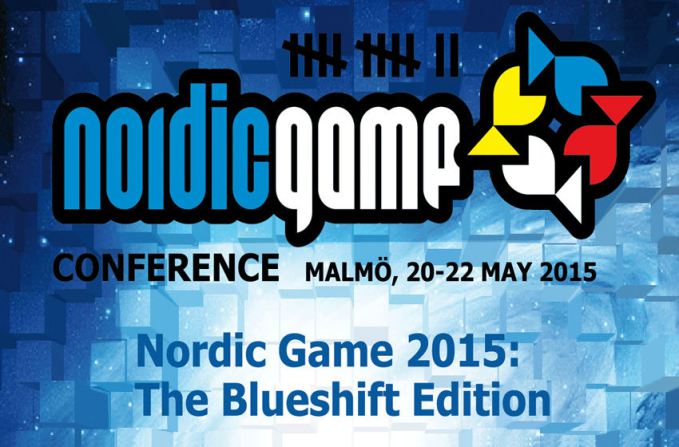
Nordic Game 2015 and couple of words about women
Finally, I got a chance to sit down and write something about Nordic Game 2015. First of all, I didn’t plan to go. I’m more into academic conferences anyway, so that’s where my money goes usually, but of course I wanted to go to a gamedev conference like this one (well, it’s not like I have been to many academic conferences) at some point just to see how they look like.
Thanks to Swedish organization Diversi promoting diversity in games, I was able to go. Diversi got money from Intel to sponsor a trip to Nordic Game in Malmö for 14 women – game designers, programmers and researchers (ok, ok, only one researcher) in order to promote diversity in the gaming industry and show that women can do cool games. Not only did Diversi pay for everything, but it organized special meetings with industry people for us as well.
People are asking me why only women, not everyone? Like, do they really need such support and why is it such a big deal?
More and more women are playing games and not only Solitary, but also MMOs and other. Half of players are women, but it does not necessarily mean that in the gaming industries proportion is the same. According to annual IGDA (International Game Developers Association) report, gaming industry consists only of 26% of women. Reasons are several starting from low confidence and ending with harassment and perceiving women as worse than men. GamerGate clearly shows how it might be harsh for women, how much discrimination and false accusations must they face (for example, read about Brianna Wu’s experience). At this point, it doesn’t matter whether Wu, Quinn or Sarkeesian are right – threatening them with rape and other horrible things is just unacceptable.
Moreover, games and playing are considered masculine activities. I bet you know this stereotype about men who are big boys and women who have to grown up quickly. They can’t play, because they are too mature for that (this is also connected with treating games as childish activity), so of course making games doesn’t sound good.
And the last, but equally important thing: women aren’t very confident. According to Hewlett-Packard internal report, they only apply for a job when they fully meet the requirements, whereas men only when 60% of them is met. The main reason is not low self-confidence, but rather fear of being rejected. Women feel the urge to be perfect, because if they aren’t, they are perceived as worse than men.
It is not about making everything easier for women, it is about equal chances. Such initiatives as Diversi’s one shows that it is crucial to think about women in the industry and show that they are not worse. Susana Meza Graham from Paradox Interactive gave a great speech about the importance of diversity in the game company. This photo perfectly sums it up:
And did you know that diversity isn’t anything new? Diversity was popular among prehistoric tribes, so this is one more thing proving that it is cool to promote it.
Changing a topic a little to the conference itself and female players – I listened to an interesting talk conducted by Salone Segal from TrulySocial Limited. Her company made a dating simulator and her speech was about engaging female audience. Of course she used as an example her own game. I don’t have anything against smart dating simulators, but during the talk I thought that Segal is trying to avoid telling something about “games for women” by trying to convince us that female players play differently. She supported this by the fact that 80% of players are females and the most crucial aspect of the game is story. You probably all know this bias that women prefer story over anything else. And you know that dating games and such are considered to be “girly”, so not many men and boys are going to play them because of that. What I would rather say is that not women play differently, but play different games in order to avoid sexist jokes in games or discrimination (“oh no, you are playing this stupid game for boys!”). For me the most important thing is to encourage diversity in games and get rid of any discrimination. David Gaider from Broward during his talk about diversity in games told us about how many people ask him to be somehow represented in his games – disabled, deaf and many other. They want to see themselves in the games. And whitewashed games full of only muscular men are simply boring. With diversity comes new plots, new ideas and refreshment, so why avoid it?
It was my first game conference and I met wonderful people there. At the beginning I felt strangely, since I was the only researcher (or rather a future researcher), but it does not mean that I don’t want to work in the gaming industry. On this conference I figured out that being a game producer might be something for me (and I don’t care how silly it does sound). So thanks Diversi for a great adventure!
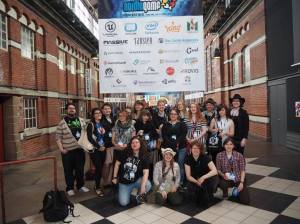
Next stop (I hope): Central and Eastern European Game Studies Conference in Cracow where I might talk about grounded theory and wargames.
Spring Seminar 2015
Spring Seminar at the University of Tampere is an annual conference where you can present work-in-progress paper and get feedback. It was my first academic conference in Finland and I don’t have much conference experience in general – I attended only to one in Poland during third year of Bachelor’s Degree.
This year seminar’s topic was adult play and Jaakko Stenros and Ashley Brown were invited as commentators. Attendants came from different parts of world (Australia, New Zealand, Germany). I submitted a paper about toys and miniatures where I’m describing similarities and differences between themselves and tackling the issue of adult play. Basically, I tried to answer the question whether is it childish to play miniature wargames or not. I also thoroughly described miniatures and toys and their features which is actually a drawback, since it’s considered to be boring and not giving any interesting results, but fortunately I received very useful feedback, so soon I will improve my paper and try to publish it somewhere.
When I told my friends about the topic of seminar, everybody was sure that I’m going to write about sex toys. They appeared on the conference thanks to Heljakka and her paper about adult play and toys. There was paper as well scrutinizing group sex as a form of play. All of them were interesting for me and I’m waiting for their full, improved versions.
But what was the most important thing for me, apart from feedback and honing presentation skills (I heard that nobody noticed that I was stressed) is the atmosphere of whole event. I was the only student there (well, there was a second one, but she was already accepted into PhD program) and that was frightening a little, but people on the conference were so nice and friendly. I could talk to them about my ideas and research and I didn’t feel like I’m worse because of lack of experience, so thanks to that, I discussed some new ideas and here they are:
- Wargaming communities (casual/hardcore players)
- These other wargames and different ways of playing (wargaming with the use of toys, making individual storyline, basically everything outside the official tournaments
- Role-playing elements in wargames
It was very good experience for me to take part in this seminar. I talked to so many people and got rid of my fear at some point. You can’t be afraid and ashamed of anything after danceoke, actually. It’s like karaoke (which Finns love), but with dancing. With bunch of scholars. You should totally try it.
Modern War in Miniature
My friend told me about an interesting RPG-like wargame when I mentioned him about my plans of writing thesis about wargames. The game is called Modern War in Miniature and was written by Michael F. Korns, probably published by himself as well in 1966 in USA. I’m in the middle of looking for information about it, but it takes time to find old wargaming zines, but I’m going to share with you what I’ve found already (hey, maybe someone is hiding old Strategy & Tactics in the attic? Or International Wargamer?)
You can buy Modern War in Miniature on Amazon, there’s also a possibility to find scanned book. It was released by M&J Research Co. I tried to find something about it, but without any success. Some people on the Internet claim that Modern War in Miniature was a proto-RPG. According to Peterson (2012), this wargame was well-known in Lake Geneva and Twin Cities before the release of Dungeons & Dragons.
However, I’m not surprised that this wargame is so willingly named proto-RPG. Take a look at this excerpt from the rulebook:
P – player
J – judge
P: Am I in the ditch now?
J: Yes, you’ve been here about 2 seconds now.
P: All right, then I’m firing my Schmeisser [39] at him in a long burst.
J: THERE IS A SUB-MACHINE GUN FIRING ON THE BOARD.
J: Your Schmeisser is kicking chunks out of the edge of the building all around him…. It’s hard to say whether you hit him or whether he pulled his head back.
J: AN M-l HAS FIRED ON THE BOARD.
J: That rifle round hit you in the side. It knocked you a little farther into the ditch; you’re bleeding from the mouth too. You can see who did it now . The American is on your left about 12 meters away running at you with his bayonet
P: Can I still move?
J: Yes, but you are almost unconscious.
P: I’m turning around and firing the rest of my Schmeisser’s clip into him.
J: THERE IS A SCHMEISSER FIRING ON THE BOARD.
J: He’s coming up fast. Your bullets are jerking around in an arc towards him as you turn. Seven meters, four meters, one meter. I’m afraid you’re dead. THE AMERICANS.
If I didn’t know I’m reading a wargame rulebook, I would think that I’m dealing with RPG rulebook. As you can see, apart from players, there is a judge. He or she is obliged to know all the rules (according the rulebook, players don’t have to), make all the checks and finally – decides what players see and hear. These RPG-like elements are in this game on purpose – Korns wanted to make a game which will realistically simulate battlefield from the perspective of single soldiers. In Korns’ game you won’t any checks connected with scouting. Furthermore, in the rulebook there are tables with actual military statistics. All this date is used to make as realistic shooting rolls as possible (basing on percentile probabilities).
Nowadays we would probably say that this game is more like RPG than wargame. I don’t know any other wargame with this kind of judge, there’s only few wargames focusing on combat with small units. One of them is called Normandy Firefight published by North Star Military Figures which focuses on close-combat of small units during IIWW. However, the approach is way different than in Modern War in Miniature, more playful. Player may give names to his soldiers and is advised to not always stick to how the real combat might have looked like, but rather have fun and engage in as much combat as possible. I rarely see such piece of advice in historical wargames, but I’m not surprised – historical wargames are different from sci-fi/fantasy ones, but I think that’s a topic for another post.
Coming back to RPG-like elements for a moment – it’s a little bit funny calling them like since first role-playing game was released in 1974. However, according to Peterson, role playing isn’t that new – wargamers tend to act out famous generals in announcements when they were looking for the players.
Here you can read more about how the play looks like, since I didn’t have a chance to play it.
If you want to read more about the beginning of RPG hobby (and thus, about first wargames), I recommend reading Jon Peterson’s book Playing at the World to which I refer in this post.
On wasting time
I did one course which includes 12 hours of workshops. During that timee, we were evaluating applications like Steam using different heuristics. I’ve learnt lots of new things and I had fun, but then I realized that we are not going to send our work anywhere. No one will ever know how many bad design issues we found on Steam and this was my first feedback after the workshops – let’s make them more meaningful and try to do more with our work.
Studying usually is connected with writing, doing small research and projects – in general with using our knowledge in many various ways. It is usually called homework. I bet that many of students treat as a sad obligation which should be done rather later than sooner. Fascinating projects and papers are in a better position, but all of them, bad and good ones, have one thing in common: after submitting or presenting them, they usually stay on our computer disks or maybe they are even erased when the work it’s done (I hope nobody does that).
I haven’t ever been encouraged to do something more with my study projects. Situation is even worse when I have to do something like that for course which is really terrible – then I really lack of motivation. I perceive my homework rather as a burden, not useful experience from which I can benefit. Interesting projects are only interesting till deadline. I’m trying to use them later, but still only when it comes to the university courses, seldom somewhere else.
Wouldn’t it be better to learn how to use our work somewhere else? Not waste it, but improve it and maybe even achieve something? Simple blog is good for that (and gathers all our work in one place) and furthermore – we can receive some additional feedback. There are plenty journals and professional blogs and websites where you can submit your work. Apart from feedback, you can gain more – new contacts, recognition and nobody tells us about these possibilities which only make the image of homework worse.
I think no one likes wasting his or her time. I hate that, but it seems I need some kind of encouragement from the outside if I want to change that. Also, people who are making their first steps in a given field, they simply do not know what they can do with their work. I’ve been interest in my wargaming stuff for some time, so it is easier for me, but still I bet there are journals, websites about which I don’t know anything.
Of course there are people who do not want to do anything more and that’s fine as well. My point is that this “homework/project stuff” is almost always perceived as something bad, boring and useless. Sometimes it really is, but often it is not and it requires some additional work to make it better – less work than in case of doing something from scratch.
My friend told me about a good solution to this problem – online service for students’ works which also provides tools for giving feedback. Once the works are gathered, it is easy to find the really good ones which are really good and advise what to do next with them. Also, our not-so-good works might be firstly reviewed by friends and after that published somewhere on Internet, so we are not going to be under fire of the hostile Internet users from the beginning.
Someone might say that this is only for people who would like to be researchers, who crave for publications, but I think everyone who is interested in a given topic might benefit from putting somewhere on the Internet his or her works – it’s just another way of developing interests.
I’m not the best example of a student who always uses all opportunities to do something with her homework. Sometimes I just say that I don’t give a fuck, because the course is so bad and boring, sometimes I’m just afraid (for example, I still have problems with putting here short reviews of books and papers which I’m reading), but I think it’s worth trying.
P.S. Take a look at this new peer-reviews student journal about games! And stay tuned, since right now I’m reading an interesting wargame from 1966 recommended by my friend.
MindTrek 2014
MindTrek is an annual conference about new technologies and future. I took part in it as a volunteer, so I will stick to sharing my thoughts rather than evaluating whole event, since I was a part of it and I wasn’t able to see everything.
I listened to Heleen Riper’s keynote (and couple of others) about e-mental healthacre. Basically, everything about using mobile applications, games and interactive media in general to track one’s mental health and giving support online. The main conclusion for all these keynotes was reducing the costs of treatment and making it easier and faster. However, the results of such support weren’t always convincing. For example when it comes to depression, treatment results are not very good. Someone showed research into playing Angry Birds – it seems that playing this game might ease symptoms of depression. Probably only temporary, but it is still interesting. Unfortunately, I didn’t hear anything about elder people and possible abusive situations connected to the access to data containing mental and physical health information and how in general this access might influence employers (maybe they will start taking care of their employees?). There were as well keynotes about big data usage, but unfortunately I didn’t have enough time to listen to them. Only when passing through the hall where they were taking place. One of the speakers had a really good presentation on two screens – on one there was his presentation and on the second: live streamed discussion of the audience.
One of the MindTrek’s stars was Lance Weiler with keynote and workshop. I wasn’t on the workshop, but I listened to the keynote. Weiler was talking about storytelling in general, but for me his whole presentation looked like: hey, I’m a cool guy doing cool things, WATCH! Maybe too many RPGs. To be more serious, I don’t really have an opinion on this keynote. I was probably too tired then and maybe Weiler was talking about things which I already know.
I took part in the two workshops. First one was about serious games for mental health. I was very disappointed. Whole so-called workshop consisted of short introduction and… Testing games made by people who were responsible for this workshop. Games are badly designed, they violate basic principles of game design such as no clear goals (or even lack of them), non-intuitivie controlling, badly used free2play mechanics and unlcear money use from it. However, these games do have potential. One of them is about gathering points by using muscles of the forearm. I can easily imagine game engaging more muscles and thus supporting process of rehabilitation.
Second workshop was organized by Headset. It was about using storytelling in therapy. We were divided into two groups with one survivor in each of them. All of participants were given roles, but survivors had special ones. They were listening to bad things about themselves from the rest of participants like you can do nothing right or you’re worthless. Survivors were supposed to answer them later by using such statements like I notice that there’s a thought which is saying… In other words, survivors had to distance themselves for the negative thoughts. It was pretty interesting experience, since I personally struggle from time to time with this kind of problems. I can’t say for sure whether this particular simulation helped someone, but I think it has a potential for teaching people how to learn this skill of “distancing”, how to cope with our own bad thinking about ourselves.
Apart from these keynotes and workshops, there was Academic MindTrek which lasted a day longer. Unfortunately, I took part only in this additional day. Whole day was divided into different tracks such as games, hybrid media or user experience. I listened to interesting papers about necessity conducting research into long-term UX. Unsurprisingly, the longer the research is, the more detailed results we can get. There was as well great paper about games and usage of the energy. It is interesting how operating systems try to optimize this usage more and more and then, game developers do not really care about that. I’m wondering what kind of impact might have games on the hardware.
There was eating and partying of course between work and sleeping. I’m really happy that volunteers had their own party and were invited for Academic MindTrek’s dinner as well. Next stop: Knudepunkt 2015
